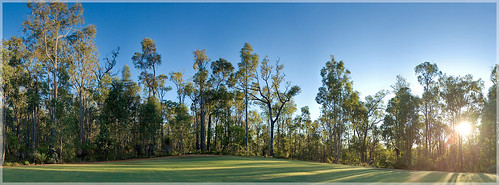Digital shooting opens up the world of stitching images to create high resolution panoramas. At the most basic level, you can pan and shoot across a scene and try to join the images in photoshop. You will soon find the seams don't match up easily all the time.
 This image is composed of 6 portrait orientation images. Zuiko 35mm shift lens. Shifted up 10mm - this allows me to include the tops of the trees while keeping the camera level. keeping the camera level means verticals remain vertical and the horizon stays flat.
This image is composed of 6 portrait orientation images. Zuiko 35mm shift lens. Shifted up 10mm - this allows me to include the tops of the trees while keeping the camera level. keeping the camera level means verticals remain vertical and the horizon stays flat.A tripod and gear to allow rotation around the nodal point of the lens are essential to eliminate parallax. This is less complex than it sounds. There is some good information about these concepts at
panoguide.com and
HereFor 'rotational' panoramas I use a Gitzo G2220 tripod and
Kingpano head. I only use the horizontal arm of the pano head because I find multirow rotational panoramas a real pain to shoot and stitch. The software I use is
PTGui which is excellent and easy to use. The website also has more information about shooting techniques.
Flat stiching can be done with a shift lens. I have a Hartblei 45 Super-rotator lens which is designed for medium format. I can perform large shifts using a Zork adapter to make full use of the large image circle the lens projects. I'll put up some information of how this lens works soon. Hopefully I'll be able to pick up a Canon 24TSE lens as well to do some wider flat stitches.
Here are a couple of links to excellent tutorials by
Jack Flesher and
Moose Peterson on flat stiching technique. This article at
Digital Outback Photo shows how to avoid parallax when flat stiching panoramas.
----------------------------------------------------
Notes on the Hartblei 45mm Super Rotator.-----------------------------------------------------
Update: May 07
I'm planning a new Panorama article....coming soon.
Some quick tips:
1. manual settings are very important - this is to keep colours and brightness of adjacent frames the same.
- all frames need to be the same exposure.
- they need to be same DOF so apperture needs to remain constant.
- keep focal distance constant. (unless focus stacking)
- don't forget to set white balance too - if you keep the camera on auto WB, the skies will be slightly different colours in each frame and stitching becomes a nightmare.
2. Rotate around nodal point to reduce parallax - especially if there are foreground elements within 3-4 meters of the camera.
3. Make sure the camera is level to prevent curved horizons and problems with verticals.
4. Shoot the frames as fast as possible to minimise changes in the clouds.
5. moving water is difficult. e.g. waves. try long exposure to blur in these situations.
6. Correct vignetting BEFORE stitching. or allow generous overlap to avoid needing to use the corners.
I've sold my Kingpano head and Hartblei lens.
Now using a RRS gear for panning and the Olympus 35 shift lens for flat stitching and perspective correction.
Will post a better article shortly....
-----------------------------------------------------
update Nov 2 2007:
Panning head is not that essential for stitching. I got some good results travelling through Europe with handheld efforts. 2 horizontal shots with Oly 21mm on 5D.

----------------------------------------
More Shooting Technique notes
HERE








